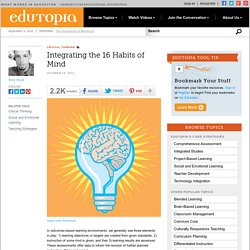

Higher Education - Disruptive Change in Higher Education. Higher Education Thomas Friedman gets it right in his op ed article The Professor’s Big Stage . Higher education is in the midst of disruptive change. A key point is that new modes of course delivery – such as MOOCs (massive open online courses) are revolutionizing higher education worldwide. MOOCs delivery modes prove to broaden access to education. However, MOOCs are most successful when blended with an in person discussion forum (here’s another great article about MOOCs and how in person peer study groups influence successful outcomes). 1. 2.
The call to action is to think differently and innovate the entire education ecosystem. Photo credit: giulia.forsythe via photopin cc. How Adaptive Testing Challenges Learners. Way back in the Olden Days (you know, when we used to take tests with papers and pencils!) , the test was the test. Question 1 was first, question 2 was second, and so on. Sometimes, to prevent students from copying answers, some teachers would mix up the questions and make multiple versions of the test so that students next to one another wouldn’t get the same version of the test. A lot of work, right? Once testing started to happen on computers, adaptive testing was born (sometimes called computer adaptive testing).
Let’s turn it into a physical body analogy: If you started working out in a gym and lifting five pound weights, but never continued to increase the weight, would your fitness/tone continue to increase? No. Four Smart Ways to Use Cell Phones in Class. Digital Tools Teaching Strategies Erin Scott By Jennifer Carey A good rule of thumb for any classroom use of cellphones: the lesson/activity must be engaging as well as productive.

You don’t want technology for the sake of technology (and students aren’t going to be intrinsically fascinated with a device they use routinely when they’re outside of school). If the students don’t enjoy what they’re doing, they will be more tempted to use their phones inappropriately. Here are some ideas: IN-CLASS POLLING/QUIZZING. IN-CLASS BACK-CHANNELING: Backchanneling refers to the use of networks & social media to maintain an online, real-time conversation alongside spoken remarks. Backchanneling can be a great way to give quiet students a voice, to introduce additional facts and insights during a lesson, or simply to encourage “conversation” during lecture or group readings when you don’t want to actually interrupt the presentation.
Poll Everywhere can also be used for this purpose. ORGANIZING RESEARCH. Integrating the 16 Habits of Mind. In outcomes-based learning environments, we generally see three elements in play: 1) learning objectives or targets are created from given standards; 2) instruction of some kind is given; and then 3) learning results are assessed.

These assessments offer data to inform the revision of further planned instruction. Rinse and repeat. But lost in this clinical sequence are the Habits of Mind that (often predictably) lead to success or failure in the mastery of given standards. In fact, it is not in the standards or assessments, but rather these personal habits where success or failure -- in academic terms -- actually begin. Below are all 16 Habits of Mind, each with a tip, strategy or resource to understand and begin implementation in your classroom.
The habits themselves aren't new at all, and significant work has already been done in the areas of these "thinking habits. " And a renewed urgency for their integration. 1. 2. 3. 4. 5. Ask students to map out their own thinking process. 4 Reasons I Love My Uncomfortable Classroom. The other day a colleague, looking at my QR codes for my student video/vocab links said “I’m so glad that I’m retiring in 3 years so I don’t have to do any tech etc. in class!”. I was dumbfounded. It’s my 18th year of teaching and my prepping and updating has never kept me busier. My classroom is not a place of comfort for me ….it’s uncomfortable and that’s good. Why do I love my uncomfortable classroom? My students are learning to ‘do for themselves’ - When students direct their learning – materials and resources need to come from a variety of sources.
My students are not just learning in class - I am amazed to see how and when they access material. Teaching has changed - My language MFL classroom is focused more and more on communicative interactive activities. Risk is not comfortable. 50 Education Technology Tools Every Teacher Should Know About. Technology and education are pretty intertwined these days and nearly every teacher has a few favorite tech tools that make doing his or her job and connecting with students a little bit easier and more fun for all involved.
Yet as with anything related to technology, new tools are hitting the market constantly and older ones rising to prominence, broadening their scope, or just adding new features that make them better matches for education, which can make it hard to keep up with the newest and most useful tools even for the most tech-savvy teachers. Here, we’ve compiled a list of some of the tech tools, including some that are becoming increasingly popular and widely used, that should be part of any teacher’s tech tool arsenal this year, whether for their own personal use or as educational aids in the classroom.